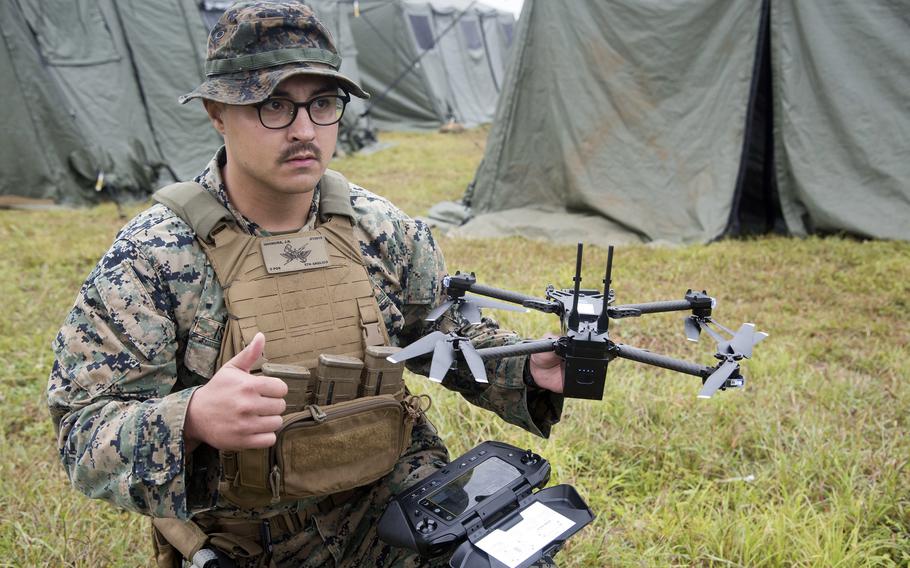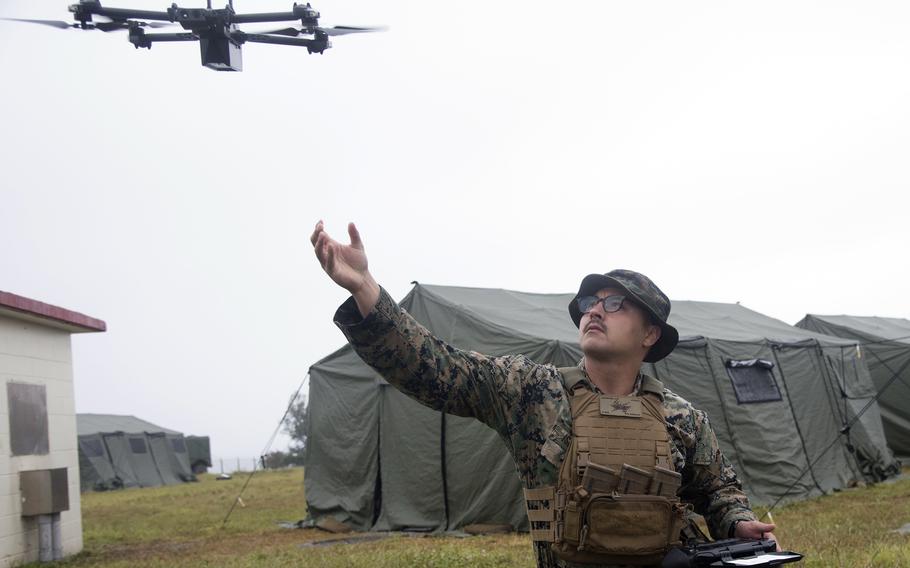
Marine Corps Sgt. Jordan Ishimura, a drone operator with the 5th Air Naval Gunfire Liaison Company, gives the all-clear for flight while demonstrating the Skydio X2D unmanned aircraft system at Ie Shima Auxiliary Airfield, Okinawa, April 23, 2025. (Brian McElhiney/Stars and Stripes)
IE SHIMA, Okinawa — U.S. Marines demonstrated how they’re using civilian drone and powered paragliding technology to provide commanders with a clearer battlefield picture during a recent drill on this Okinawa island.
The III Marine Expeditionary Force Information Group is conducting its first Kaiju Rain exercise at sites across Okinawa, including Ie Shima Auxiliary Airfield, and in South Korea through May 15.
The exercise combines four annual training events led by separate elements of the group into a rehearsal of sensor capabilities across the unit, “in order to be the joint terminal attack controller of the joint force,” commander Col. Joshua Mayoral said in an email Wednesday.
To identify enemy vessels in waters surrounding Ie Shima, the 5th Air Naval Gunfire Liaison Company, or ANGLICO, used small, unmanned aircraft such as the Skydio X2 drone, team leader Capt. Pat Benn said during Wednesday’s demonstration.
Heavy rain and fog prevented drone and paraglider flights that morning. However, Sgt. Jordan Ishimura briefly flew a drone about 20 feet into the air.
“Generally [the weather] has been favorable for the last week or so,” Benn said.

Marine Corps Sgt. Jordan Ishimura, a drone operator with the 5th Air Naval Gunfire Liaison Company, launches a Skydio X2D unmanned aircraft system at Ie Shima Auxiliary Airfield, Okinawa, April 23, 2025. (Brian McElhiney/Stars and Stripes)
The company led Katana Strike, one of the four exercises under Kaiju Rain, through Friday.
“We have redundancy in our sensor game plan, so we employ a number of different sensors,” including binoculars, to provide intelligence for command units, he said.
The Marines’ version of Skydio’s X2D, which the 5th ANGLICO has used for about a year, has a range of up to 3 ½ miles and is equipped with cameras that can digitally zoom up to 16 times, Benn said.
A four-Marine team runs drone missions for the company — one to operate the drone, two communications Marines, and one security Marine on lookout, he said.
“For expeditionary advanced base operations, the Marine Corps needs to be well-informed,” Benn said. The company provides commanders with “awareness of the battle space and assured command and control so they can make not only safe but effective decisions.”
Expeditionary advanced base operations — a key tenet of the Marines’ Force Design plan — calls for small, mobile groups of Marines to disperse within the range of enemy missiles to seize and hold islands and sink enemy vessels.
The 3rd Radio Battalion, deployed from Kaneohe, Hawaii, used powered paragliders during its portion of the exercise, dubbed Corvus Dawn, to quickly insert and extract six-Marine teams to conduct missions, said Master Sgt. Matthew Webb, operations chief for Bravo Company.
The paragliders, which have a 100-mile range, allow Marines to travel farther without air support, he said. Flying them over open ocean is “under review.”
The battalion has been using the paragliders for the past year. Sgt. Brett Kite said flying one “takes some getting used to.”
“It’s similar to the canopy flight to a certain degree, but … it is its own insert platform,” he said.
The battalion plans to use its sensing capabilities early in a conflict, commander Lt. Col. Gary Keefer said after the demonstration.
“From a Force Design perspective, we are demonstrating our capacity to be an element of the JTAC for the joint force and our ability to sense on behalf of the joint force,” he said.